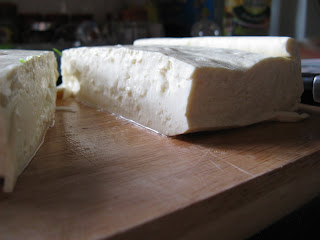 I have a terrible habit of buying cookery books, pouring over them hungrily, and then leaving on the shelf, never to be cooked from. I decided that this should change, so I tackled a recipe from the Moro cookbook.
I have a terrible habit of buying cookery books, pouring over them hungrily, and then leaving on the shelf, never to be cooked from. I decided that this should change, so I tackled a recipe from the Moro cookbook.I've never been to the restaurant, nor have I tried Moorish food but this recipe was very straight-forward. It also used one of my favourite vegetables: the aubergine. Given the current rising food costs and my seemingly-perpetual poorness, I've been shopping at Lewisham market recently. It really is a god-send; I picked up half a kilo of baby plum tomatoes for 58p, 3 aubergines for £1.20 and three peppers for £1. This was almost half the price of nearby Sainsburys.
So anyway, the recipe.
Aubergine & Red Pepper Salad
Serves 4 as a side
3 aubergines
3 red peppers (I used 2 red and one yellow)
1 garlic clove, crushed
A squeeze of lemon
2 tbsp olive oil
200gr low fat yoghurt
Caramelised butter, about 30gr
A few sprigs of fresh coriander
Salt and pepper
Prick the aubergines and peppers and roast in the oven until the aubergines have collapsed. The aubergines take about 45 mins and the peppers about 25 mins, on gas mark 7. Remove from the oven and allow to cool slightly. Peel the skin from the peppers and the aubergines. Chop the aubergine flesh roughly and spread out on a plate. Add the olive oil, lemon juice, garlic, salt and pepper and toss. Deskin the peppers and chop into slices. Drape this over the aubergine. Spoon the yoghurt on one side of the dish.
To make caramelised butter, heat some unsalted butter in a pan. Continue to heat it, swirling it around the pan occasionally, until the sediment in the pan becomes brown, but doesn't burn. Pour this over the dish. Serve with flatbreads.
This was a really delicious introduction to Moorish food. I think that amount of yoghurt was a touch too much, so I might reduce it by half next time. I think a bit of minced lamb with parsley, added to this dish, would make a great meal.
 Ok, so it's Wednesday. I got home late on Tuesday night and started making this, but then got hungry waiting for it to cook I had to scoff some Mi Goreng noodles. Thankfully this is the kind of recipe that benefits from the flavours sitting overnight to amalgamate. I was also able to use my new claypot that I bought for £3. Claypots need to be soaked for 24 hours before their first use, and then whatever you cook needs to be in the oven, gradually building heat otherwise it'll shatter. It was a bit nerve-racking, especially when you're hungry.
Ok, so it's Wednesday. I got home late on Tuesday night and started making this, but then got hungry waiting for it to cook I had to scoff some Mi Goreng noodles. Thankfully this is the kind of recipe that benefits from the flavours sitting overnight to amalgamate. I was also able to use my new claypot that I bought for £3. Claypots need to be soaked for 24 hours before their first use, and then whatever you cook needs to be in the oven, gradually building heat otherwise it'll shatter. It was a bit nerve-racking, especially when you're hungry.












 I suspect if we made it out fishing we would have
I suspect if we made it out fishing we would have 









